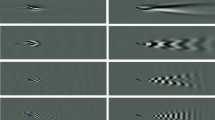Abstract
The breeding method has been widely used to generate ensemble perturbations in ensemble forecasting due to its simple concept and low computational cost. This method produces the fastest growing perturbation modes to catch the growing components in analysis errors. However, the bred vectors (BVs) are evolved on the same dynamical flow, which may increase the dependence of perturbations. In contrast, the nonlinear local Lyapunov vector (NLLV) scheme generates flow-dependent perturbations as in the breeding method, but regularly conducts the Gram–Schmidt reorthonormalization processes on the perturbations. The resulting NLLVs span the fast-growing perturbation subspace efficiently, and thus may grasp more components in analysis errors than the BVs.
In this paper, the NLLVs are employed to generate initial ensemble perturbations in a barotropic quasi-geostrophic model. The performances of the ensemble forecasts of the NLLV method are systematically compared to those of the random perturbation (RP) technique, and the BV method, as well as its improved version—the ensemble transform Kalman filter (ETKF) method. The results demonstrate that the RP technique has the worst performance in ensemble forecasts, which indicates the importance of a flow-dependent initialization scheme. The ensemble perturbation subspaces of the NLLV and ETKF methods are preliminarily shown to catch similar components of analysis errors, which exceed that of the BVs. However, the NLLV scheme demonstrates slightly higher ensemble forecast skill than the ETKF scheme. In addition, the NLLV scheme involves a significantly simpler algorithm and less computation time than the ETKF method, and both demonstrate better ensemble forecast skill than the BV scheme.
Similar content being viewed by others
References
Anderson, J. L., and S. Anderson, 1999. A Monte Carlo implementation of the nonlinear filtering problem to produce ensemble assimilations and forecasts. Mon. Wea. Rev., 127, 2741–2758.
Barkmeijer, J., 1992. Local error growth in a barotropic model. Tellus A, 44, 314–323.
Benettin, G., L. Galgani, A. Giorgilli, and J. M. Strelcyn, 1980. Lyapunov characteristic exponents for smooth dynamical systems and for Hamiltonian systems; a method for computing all of them. Part 1: Theory. Meccanica, 15, 9–20.
Bishop, C. H., B. J. Etherton, and S. J. Majumdar, 2001. Adaptive sampling with the ensemble transform Kalman filter. Part I: theoretical aspects. Mon. Wea. Rev., 129, 420–436.
Bowler, N. E., 2006. Comparison of error breeding, singular vectors, random perturbations and ensemble Kalman filter perturbation strategies on a simple model. Tellus A, 58, 538–548.
Buizza, R., P. L. Houtekamer, Z. Toth, G. Pellerin, M. Z, Wei, and Y. J. Zhu, 2005. A comparison of the ECMWF, MSC, and NCEP global ensemble prediction systems. Mon. Wea. Rev., 133, 1076–1097.
Carrassi, A., A. Trevisan, and F. Uboldi, 2007: Adaptive observations and assimilation in the unstable subspace by breeding on the data assimilation system. Tellus A, 59(1), 101–113.
Cheung, K. K. W., and J. C. L. Chan, 1999. Ensemble forecasting of tropical cyclone motion using a barotropic model. Part I: perturbations of the environment. Mon. Wea. Rev., 127, 1229–1243.
Descamps, L., and O. Talagrand, 2007. On some aspects of the definition of initial conditions for ensemble prediction. Mon. Wea. Rev., 135, 3260–3272.
Ding, R. Q., and J. P. Li, 2007. Nonlinear finite-time Lyapunov exponent and predictability. Physics Letters A, 364, 396–400.
Ding, R. Q., J. P. Li, and K.-J. Ha, 2008: Trends and interdecadal changes of weather predictability during 1950s-1990s. J. Geophys. Res., 113, D24112, doi: 10.1029/2008JD010404.
Ding, R. Q., J. P. Li, and K.-H. Seo, 2010. Predictability of the Madden-Julian oscillation estimated using observational data. Mon. Wea. Rev., 138, 1004–1013.
Ding, R. Q., J. P. Li, and K.-H. Seo, 2011. Estimate of the predictability of boreal summer and winter intraseasonal oscillations from observations. Mon. Wea. Rev., 139, 2421–2438.
Duan, W. S., and Z. H. Huo, 2016. An approach to generating mutually independent initial perturbations for ensemble forecasts: orthogonal conditional nonlinear optimal perturbations. J. Atmos. Sci., 73, 997–1014, doi: 10.1175/JAS-D-15-0138.1.
Durran, D. R., and M. Gingrich, 2014. Atmospheric predictability: Why butterflies are not of practical importance. J. Atmos. Sci., 71, 2476–2488.
Epstein, E. S., 1969. Stochastic dynamic prediction. Tellus, 21, 739–759.
Evensen, G., 2003. The ensemble Kalman filter: theoretical formulation and practical implementation. Ocean Dynamics, 53, 343–367.
Evensen, G., 2004. Sampling strategies and square root analysis schemes for the EnKF. Ocean Dynamics, 54, 539–560.
Feng, J., R. Q. Ding, D. Q. Liu, and J. P. Li, 2014: The application of nonlinear local Lyapunov vectors to ensemble predictions in the Lorenz systems. J. Atmos. Sci., 71(9), 3554–3567.
Fraedrich, K., 1987. Estimating weather and climate predictability on attractors. J. Atmos. Sci., 44, 722–728.
Gaspari, G., and S. E. Cohn, 1999. Construction of correlation functions in two and three dimensions. Quart. J. Roy. Meteor. Soc., 125, 723–757.
Houtekamer, P. L., and H. L. Mitchell, 1998. Data assimilation using an ensemble Kalman filter technique. Mon. Wea. Rev., 126, 796–811.
Houtekamer, P. L., and H. L. Mitchell, 2001. A sequential ensemble Kalman filter for atmospheric data assimilation. Mon. Wea. Rev., 129, 123–137.
Kalnay, E., 2002: Atmospheric Modeling, Data Assimilation and Predictability. Cambridge University Press, 221 pp.
Lawrence, A. R., M. Leutbecher, and T. N. Palmer, 2009. The characteristics of Hessian singular vectors using an advanced data assimilation scheme. Quart. J. Roy. Meteor. Soc., 135, 1117–1132.
Leith, C. E., 1974. Theoretical skill of Monte Carlo forecasts. Mon. Wea. Rev., 102, 409–418.
Li, J. P., and J. F. Chou, 1997: Existence of the atmosphere attractor. Science in China Series D: Earth Sciences, 40(2), 215–220.
Li, J. P., and S. H. Wang, 2008. Some mathematical and numerical issues in geophysical fluid dynamics and climate dynamics. Communications in Computational Physics, 3, 759–793.
Li, J. P., and R. Q. Ding, 2011. Temporal-spatial distribution of atmospheric predictability limit by local dynamical analogs. Mon. Wea. Rev., 139, 3265–3283.
Li, J. P., and R. Q. Ding, 2013. Temporal-spatial distribution of the predictability limit of monthly sea surface temperature in the global oceans. Int. J. Climatol., 33, 1936–1947.
Li, J. P., R. Q. Ding, and B. H. Chen, 2006: Review and Prospect on the Predictability Study of the Atmosphere. Review and Prospects of the Developments of Atmosphere Sciences in Early 21st Century. China Meteorology Press, 96–104. (in Chinese)
Lorenz, E. N., 1965. A study of the predictability of a 28-variable atmospheric model. Tellus, 17, 321–333.
Magnusson, L., E. Källén, and J. Nycander, 2008. Initial state perturbations in ensemble forecasting. Nonlinear Processes in Geophysics, 15, 751–759.
Magnusson, L., J. Nycander, and E. Källén, 2009: Flow-dependent versus flow-independent initial perturbations for ensemble prediction. Tellus A, 61(2), 194–209.
Molteni, F., R. Buizza, T. N. Palmer, and T. Petroliagis, 1996. The new ECMWF ensemble prediction system: methodology and validation. Quart. J. Roy. Meteor. Soc., 122, 73–119.
Mu, M., and Z. Y. Zhang, 2006. Conditional nonlinear optimal perturbations of a two-dimensional quasigeostrophic model. J. Atmos. Sci., 63, 1587–1604.
Mu, M., and Z. N. Jiang, 2008. A new approach to the generation of initial perturbations for ensemble prediction: Conditional nonlinear optimal perturbation. Chinese Science Bulletin, 53, 2062–2068.
Murphy, A. H., 1973. A new vector partition of the probability score. J. Appl. Meteor., 12, 595–600.
Palatella, L., and A. Trevisan, 2015. Interaction of Lyapunov vectors in the formulation of the nonlinear extension of the Kalman filter. Physical Review E, 91, 042905.
Peña, M., and Z. Toth, 2014: Estimation of analysis and forecast error variances. Tellus A, 66, 21767.
Stephenson, D. B., C. A. S. Coelho, and I. T. Jolliffe, 2008: Two extra components in the Brier Score decomposition. Mon. Wea. Rev., 23, 752–757.
Toth, Z., and E. Kalnay, 1993. Ensemble forecasting at NMC: The generation of perturbations. Bull. Amer. Meteor. Soc., 74, 2317–2330.
Toth, Z., and E. Kalnay, 1997. Ensemble forecasting at NCEP and the breeding method. Mon. Wea. Rev., 125, 3297–3319.
Trevisan, A., and R. Legnani, 1995. Transient error growth and local predictability: A study in the Lorenz system. Tellus A, 47, 103–117.
Trevisan, A., and F. Uboldi, 2004. Assimilation of standard and targeted observations within the unstable subspace of the observation-analysis-forecast cycle system. J. Atmos. Sci., 61, 103–113.
Trevisan, A., and L. Palatella, 2011: Chaos and weather forecasting: the role of the unstable subspace in predictability and state estimation problems. International Journal of Bifurcation and Chaos, 21(12), 3389–3415.
Vannitsem, S., and C. Nicolis, 1997. Lyapunov vectors and error growth patterns in a T21L3 quasigeostrophic model. J. Atmos. Sci., 54, 347–361.
Wang, X., and C. H. Bishop, 2003. A comparison of breeding and ensemble transform Kalman filter ensemble forecast schemes. J. Atmos. Sci., 60, 1140–1158.
Wei, M. Z., Z. Toth, R. Wobus, Y. J. Zhu, C. H. Bishop, and X. G. Wang, 2006. Ensemble transform Kalman filter-based ensemble perturbations in an operational global prediction system at NCEP. Tellus A, 58, 28–44.
Wei, M. Z., Z. Toth, R. Wobus, and Y. J. Zhu, 2008. Initial perturbations based on the ensemble transform (ET) technique in the NCEP global operational forecast system. Tellus A, 60, 62–79.
Wolf, A., J. B. Swift, H. L. Swinney, and J. A. Vastano, 1985. Determining Lyapunov exponents from a time series. Physica D, 16, 285–317.
Yoden, S., and M. Nomura, 1993. Finite-time Lyapunov stability analysis and its application to atmospheric predictability. J. Atmos. Sci., 50, 1531–1543.
Zhang, J., W. S. Duan, and X. F. Zhi, 2015: Using CMIP5 model outputs to investigate the initial errors that cause the “spring predictability barrier” for El Niño events. Science China Earth Sciences, 58(5), 685–696.
Ziehmann, C., L. A. Smith, and J. Kurths, 2000. Localized Lyapunov exponents and the prediction of predictability. Physics Letters A, 271, 237–251.
Author information
Authors and Affiliations
Corresponding author
Rights and permissions
About this article
Cite this article
Feng, J., Ding, R., Li, J. et al. Comparison of nonlinear local Lyapunov vectors with bred vectors, random perturbations and ensemble transform Kalman filter strategies in a barotropic model. Adv. Atmos. Sci. 33, 1036–1046 (2016). https://doi.org/10.1007/s00376-016-6003-4
Received:
Revised:
Accepted:
Published:
Issue Date:
DOI: https://doi.org/10.1007/s00376-016-6003-4




